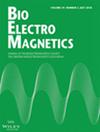Nur Syarah Zulaikha Mohd Razak, Anita Abd Rahman, Halimatus Sakdiah Minhat, Fatimah Ahmad Fauzi
求助PDF
{"title":"了解来自手机射频辐射(RFR)暴露的电磁超敏反应(EHS):一种混合方法研究方案","authors":"Nur Syarah Zulaikha Mohd Razak, Anita Abd Rahman, Halimatus Sakdiah Minhat, Fatimah Ahmad Fauzi","doi":"10.1002/bem.70007","DOIUrl":null,"url":null,"abstract":"<div>\n \n <p>More than 7 billion mobile phone users were recorded worldwide in 2022. Radiofrequency radiation (RFR) from mobile phones can produce radiobiological effects, which may lead to electromagnetic hypersensitivity (EHS) in humans. This study employs a mixed-method approach: the quantitative component identifies predictors of EHS from mobile phone RFR using the biopsychosocial model, whereas the qualitative component explores individual experiences that contribute to EHS. Quantitative analysis is conducted using the Statistical Package for the Social Sciences (SPSS) version 25.0 for descriptive and analytical statistics, whereas qualitative analysis is carried out with NVivo version 14 for thematic analysis. Findings from both analyses are compared and discussed to highlight similarities and differences, providing a richer, in-depth understanding of EHS resulting from mobile phone RFR exposure among undergraduate students. The study sample consists of 351 undergraduate students aged 18–25 from Universiti Putra Malaysia (UPM), conducted between April 2023 and December 2023. Approval was obtained from the Ethics Committee for Research Involving Human Subjects at UPM before the study. The quantitative component uses a proportionate simple random sampling method with a validated questionnaire, whereas the qualitative component utilizes purposive sampling through in-depth interviews. Enhancing understanding of EHS may contribute to new knowledge and raise awareness of its potential effects on the population. Bioelectromagnetics. 00:00–00, 2025. © 2025 Bioelectromagnetics Society.</p></div>","PeriodicalId":8956,"journal":{"name":"Bioelectromagnetics","volume":"46 4","pages":""},"PeriodicalIF":1.2000,"publicationDate":"2025-04-28","publicationTypes":"Journal Article","fieldsOfStudy":null,"isOpenAccess":false,"openAccessPdf":"","citationCount":"0","resultStr":"{\"title\":\"Understanding Electromagnetic Hypersensitivity (EHS) From Mobile Phone Radiofrequency Radiation (RFR) Exposure: A Mixed-Method Study Protocol\",\"authors\":\"Nur Syarah Zulaikha Mohd Razak, Anita Abd Rahman, Halimatus Sakdiah Minhat, Fatimah Ahmad Fauzi\",\"doi\":\"10.1002/bem.70007\",\"DOIUrl\":null,\"url\":null,\"abstract\":\"<div>\\n \\n <p>More than 7 billion mobile phone users were recorded worldwide in 2022. Radiofrequency radiation (RFR) from mobile phones can produce radiobiological effects, which may lead to electromagnetic hypersensitivity (EHS) in humans. This study employs a mixed-method approach: the quantitative component identifies predictors of EHS from mobile phone RFR using the biopsychosocial model, whereas the qualitative component explores individual experiences that contribute to EHS. Quantitative analysis is conducted using the Statistical Package for the Social Sciences (SPSS) version 25.0 for descriptive and analytical statistics, whereas qualitative analysis is carried out with NVivo version 14 for thematic analysis. Findings from both analyses are compared and discussed to highlight similarities and differences, providing a richer, in-depth understanding of EHS resulting from mobile phone RFR exposure among undergraduate students. The study sample consists of 351 undergraduate students aged 18–25 from Universiti Putra Malaysia (UPM), conducted between April 2023 and December 2023. Approval was obtained from the Ethics Committee for Research Involving Human Subjects at UPM before the study. The quantitative component uses a proportionate simple random sampling method with a validated questionnaire, whereas the qualitative component utilizes purposive sampling through in-depth interviews. Enhancing understanding of EHS may contribute to new knowledge and raise awareness of its potential effects on the population. Bioelectromagnetics. 00:00–00, 2025. © 2025 Bioelectromagnetics Society.</p></div>\",\"PeriodicalId\":8956,\"journal\":{\"name\":\"Bioelectromagnetics\",\"volume\":\"46 4\",\"pages\":\"\"},\"PeriodicalIF\":1.2000,\"publicationDate\":\"2025-04-28\",\"publicationTypes\":\"Journal Article\",\"fieldsOfStudy\":null,\"isOpenAccess\":false,\"openAccessPdf\":\"\",\"citationCount\":\"0\",\"resultStr\":null,\"platform\":\"Semanticscholar\",\"paperid\":null,\"PeriodicalName\":\"Bioelectromagnetics\",\"FirstCategoryId\":\"99\",\"ListUrlMain\":\"https://onlinelibrary.wiley.com/doi/10.1002/bem.70007\",\"RegionNum\":3,\"RegionCategory\":\"生物学\",\"ArticlePicture\":[],\"TitleCN\":null,\"AbstractTextCN\":null,\"PMCID\":null,\"EPubDate\":\"\",\"PubModel\":\"\",\"JCR\":\"Q3\",\"JCRName\":\"BIOLOGY\",\"Score\":null,\"Total\":0}","platform":"Semanticscholar","paperid":null,"PeriodicalName":"Bioelectromagnetics","FirstCategoryId":"99","ListUrlMain":"https://onlinelibrary.wiley.com/doi/10.1002/bem.70007","RegionNum":3,"RegionCategory":"生物学","ArticlePicture":[],"TitleCN":null,"AbstractTextCN":null,"PMCID":null,"EPubDate":"","PubModel":"","JCR":"Q3","JCRName":"BIOLOGY","Score":null,"Total":0}
引用次数: 0
引用
批量引用

 求助内容:
求助内容: 应助结果提醒方式:
应助结果提醒方式:


